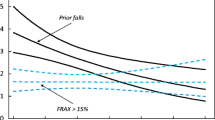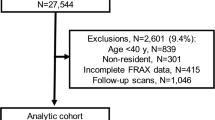Abstract
Summary
Falls are a major concern in terms of fracture risk. Although awareness rising for the absence of falls in the FRAX algorithm, our study only identified the independent predictive role of previous recurrent falls and their better conjunction use with FRAX for major osteoporotic fracture prediction in older Chinese men.
Introduction
Although the association of falls with fracture has been widely explored, the impact of previous falls is not included in the FRAX algorithm currently. Our aim was to examine the FRAX-independent associations between falls in the previous year and subsequent fracture risk, as well as the conjunctive use of falls and the FRAX score for major osteoporotic fracture (MOF) prediction in older Chinese people.
Methods
Four thousand community older men and women aged 65 years or older were followed up for 9.9 ± 2.7 and 8.8 ± 1.5 years, respectively. The associations between falls in the previous 1 year and MOF risk by follow-up years were evaluated using the Fine and Gray model. New prediction scores were calculated by incorporating the falls and FRAX scores using the Fine and Gray model, or developed by adjusting the FRAX scores by 30% increased risk for each fall in the previous year. The predictive powers for MOF risk between the new scores and FRAX scores were evaluated by the area under the curve (AUC) and category-based net reclassification improvement index (NRI).
Results
During the follow-up period, 139 (7.0%) men and 236 (11.8%) women had at least one incident MOF. One previous fall significantly predicted the first year incident MOF in men [hazard ratio (HR) (95%CI), 3.47 (1.02, 11.80)]. Previous recurrent falls significantly predicted a 10-year incident MOF in men [HR (95%CI), 2.42 (1.30, 4.51)]. In men, the fall-adjusting FRAX scores showed significant improvement on total net reclassification of fracture (3–6%). No improved predictive accuracy shown in women.
Conclusion
Falls in the previous year are likely to provide some predictive power to FRAX for MOF risk assessment in older Chinese men, but not women.
Similar content being viewed by others
References
Centers for Disease Control and Prevention (2006) Fatalities and injuries from falls among older adults--United States, 1993-2003 and 2001-2005. MMWR Morb Mortal Wkly Rep 55:1221–1224
Masud T, Morris RO (2001) Epidemiology of falls. Age Ageing 30(Suppl 4):3–7
Peeters G, van Schoor NM, Lips P (2009) Fall risk: the clinical relevance of falls and how to integrate fall risk with fracture risk. Best Pract Res Clin Rheumatol 23:797–804
Woo J, Leung J, Wong S, Kwok T, Lee J, Lynn H (2009) Development of a simple scoring tool in the primary care setting for prediction of recurrent falls in men and women aged 65 years and over living in the community. J Clin Nurs 18:1038–1048
Tromp AM, Pluijm SM, Smit JH, Deeg DJ, Bouter LM, Lips P (2001) Fall-risk screening test: a prospective study on predictors for falls in community-dwelling elderly. J Clin Epidemiol 54:837–844
Kanis JA, Hans D, Cooper C, Baim S, Bilezikian JP, Binkley N, Cauley JA, Compston JE, Dawson-Hughes B, El-Hajj Fuleihan G, Johansson H, Leslie WD, Lewiecki EM, Luckey M, Oden A, Papapoulos SE, Poiana C, Rizzoli R, Wahl DA, McCloskey EV (2011) Interpretation and use of FRAX in clinical practice. Osteoporos Int 22:2395–2411
Masud T, Binkley N, Boonen S, Hannan MT (2011) Official positions for FRAX® clinical regarding falls and frailty: can falls and frailty be used in FRAX®? From Joint Official Positions Development Conference of the International Society for Clinical Densitometry and International Osteoporosis Foundation on FRAX®. J Clin Densitom 14:194–204
Wolbers M, Koller MT, Witteman JC, Steyerberg EW (2009) Prognostic models with competing risks: methods and application to coronary risk prediction. Epidemiology 20:555–561
Kwok AW, Gong JS, Wang YX, Leung JC, Kwok T, Griffith JF, Leung PC (2013) Prevalence and risk factors of radiographic vertebral fractures in elderly Chinese men and women: results of Mr. OS (Hong Kong) and Ms. OS (Hong Kong) studies. Osteoporos Int 24:877–885
Kwok TCY, Su Y, Khoo CC, Leung J, Kwok A, Orwoll E, Woo J, Leung PC (2017) Predictors of non-vertebral fracture in older Chinese males and females: Mr. OS and Ms. OS (Hong Kong). J Bone Miner Metab 35:330–337
Kanis JA, McCloskey EV, Johansson H, Oden A, Melton LJ 3rd, Khaltaev N (2008) A reference standard for the description of osteoporosis. Bone 42:467–475
Looker AC, Wahner HW, Dunn WL, Calvo MS, Harris TB, Heyse SP, Johnston CC Jr, Lindsay R (1998) Updated data on proximal femur bone mineral levels of US adults. Osteoporos Int 8:468–489
Schousboe JT (2007) Cost-effectiveness modeling research of pharmacologic therapy to prevent osteoporosis-related fractures. Curr Rheumatol Rep 9:50–56
Chan DC, McCloskey EV, Chang CB, Lin KP, Lim LC, Tsai KS, Yang RS (2017) Establishing and evaluating FRAX(R) probability thresholds in Taiwan. J Formos Med Assoc 116:161–168
Su Y, Leung J, Hans D, Lamy O, Kwok T (2017) The added value of trabecular bone score to FRAX® to predict major osteoporotic fractures for clinical use in Chinese older people: the Mr. OS and Ms. OS cohort study in Hong Kong. Osteoporos Int 28:111–117
Fine JP, Gray RJ (1999) A proportional hazards model for the subdistribution of a competing risk. J Am Stat Assoc 94:496–509
Koller MT, Leening MJ, Wolbers M, Steyerberg EW, Hunink MG, Schoop R, Hofman A, Bucher HC, Psaty BM, Lloyd-Jones DM, Witteman JC (2012) Development and validation of a coronary risk prediction model for older U.S. and European persons in the Cardiovascular Health Study and the Rotterdam Study. Ann Intern Med 157:389–397
DeLong ER, DeLong DM, Clarke-Pearson DL (1988) Comparing the areas under two or more correlated receiver operating characteristic curves: a nonparametric approach. Biometrics 44:837–845
Pencina MJ, D'Agostino RB Sr, D’Agostino RB Jr, Vasan RS (2008) Evaluating the added predictive ability of a new marker: from area under the ROC curve to reclassification and beyond. Stat Med 27:157–172 discussion 207-112
Kennedy K, Pencina M A SAS® macro to compute added predictive ability of new markers predicting a dichotomous outcome. In: SouthEast SAS Users Group Annual Meeting Proceedings 2010; http://analytics.ncsu.edu/sesug/2010/SDA07.Kennedy.pdf
Frost M, Abrahamsen B, Masud T, Brixen K (2012) Risk factors for fracture in elderly men: a population-based prospective study. Osteoporos Int 23:521–531
Geusens P, Milisen K, Dejaeger E, Boonen S (2003) Falls and fractures in postmenopausal women: a review. J Br Menopause Soc 9:101–106
Albrand G, Munoz F, Sornay-Rendu E, DuBoeuf F, Delmas PD (2003) Independent predictors of all osteoporosis-related fractures in healthy postmenopausal women: the OFELY study. Bone 32:78–85
Edwards MH, Jameson K, Denison H, Harvey NC, Sayer AA, Dennison EM, Cooper C (2013) Clinical risk factors, bone density and fall history in the prediction of incident fracture among men and women. Bone 52:541–547
Harvey NC, Johansson H, Oden A, Karlsson MK, Rosengren BE, Ljunggren O, Cooper C, McCloskey E, Kanis JA, Ohlsson C, Mellstrom D (2016) FRAX predicts incident falls in elderly men: findings from MrOs Sweden. Osteoporos Int 27:267–274
Gardsell P, Johnell O, Nilsson BE, Nilsson JA (1989) The predictive value of fracture, disease, and falling tendency for fragility fractures in women. Calcif Tissue Int 45:327–330
Sandhu SK, Nguyen ND, Center JR, Pocock NA, Eisman JA, Nguyen TV (2010) Prognosis of fracture: evaluation of predictive accuracy of the FRAX algorithm and Garvan nomogram. Osteoporos Int 21:863–871
Cummings SR, Nevitt MC, Kidd S (1988) Forgetting falls. The limited accuracy of recall of falls in the elderly. J Am Geriatr Soc 36:613–616
Tinetti ME, Speechley M, Ginter SF (1988) Risk factors for falls among elderly persons living in the community. N Engl J Med 319:1701–1707
Tromp AM, Smit JH, Deeg DJ, Bouter LM, Lips P (1998) Predictors for falls and fractures in the Longitudinal Aging Study Amsterdam. J Bone Miner Res 13:1932–1939
Acknowledgements
The authors wish to thank all dedicated participants contributing to the study and The Chinese University of Hong Kong Jockey Club Centre for Osteoporosis Care and Control supporting the study.
Funding
The study was funded by the National Institutes of Health R01 grant AR049439–01A1 and the Research Grants Council Earmarked Grant CUHK4101/02 M.
Author information
Authors and Affiliations
Corresponding author
Ethics declarations
Conflicts of interest
None.
Ethical approval
All procedures performed in the studies involving human participants were in accordance with the ethical standards of the institutional and/or national research committee and with the 1964 Helsinki Declaration and its later amendments or comparable ethical standards. The study was approved by the Clinical Research Ethics Committee of The Chinese University of Hong Kong.
Statement of informed consent
Informed consent was obtained from all individual participants included in the study.
Electronic supplementary material
ESM 1
(DOCX 20 kb).
Rights and permissions
About this article
Cite this article
Su, Y., Leung, J. & Kwok, T. The role of previous falls in major osteoporotic fracture prediction in conjunction with FRAX in older Chinese men and women: the Mr. OS and Ms. OS cohort study in Hong Kong. Osteoporos Int 29, 355–363 (2018). https://doi.org/10.1007/s00198-017-4277-8
Received:
Accepted:
Published:
Issue Date:
DOI: https://doi.org/10.1007/s00198-017-4277-8




